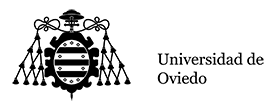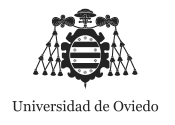Estudia
- Artes y humanidades
-
Ciencias
- Máster Erasmus Mundus en Recursos Biológicos Marinos
- Máster Universitario en Análisis de Datos para la Inteligencia de Negocios
- Máster Universitario en Biotecnología Alimentaria
- Máster Universitario en Biotecnología Aplicada a la Conservación y Gestión Sostenible de Recursos Vegetales
- Máster Universitario en Biotecnología del Medio Ambiente y la Salud
- Máster Universitario en Ciencias Analíticas y Bioanalíticas
- Máster Universitario en Conservación Marina
- Máster Universitario en Física Avanzada: Partículas, Astrofísica, Nanofísica y Materiales Cuánticos
- Máster Universitario en Modelización e Investigación Matemática, Estadística y Computación*
- Máster Universitario en Química Teórica y Modelización Computacional
- Máster Universitario en Química y Desarrollo Sostenible
- Máster Universitario en Recursos Geológicos e Ingeniería Geológica
- Ciencias de la salud
- Ciencias sociales y jurídicas
- Ingeniería y arquitectura
- Información, acceso y becas
Técnicas para el Análisis de Sólidos y Superficies
- Prácticas de Aula/Semina (3 Horas)
- Clases Expositivas (16.5 Horas)
- Tutorías Grupales (3 Horas)
This course will allow the student to get familiarized with important techniques for direct solid analysis (including coatings, thin films and surfaces). Particular attention will be paid to those powerful analytical techniques nowadays widely used at Industries, Research Centres and Universities. Principles, instrumentation, analytical performance and fields of application of the different techniques will be explained as an integrated platform.
“Techniques for Solid and Surface Analysis”, with 3 ECTS credits, goes into the Module 1 (compulsory courses, first semester) and will be teach in English.
The prerequisites are the same as those for the other courses within the first semester of this Master.
This course is addressed to recent graduate students in the Science field (B.Sc.), including chemistry, physics, geology, engineering, biochemistry, biology, etc, as well as to high school teachers, researchers and professionals from industries.
In this course the student will learn general concepts about principles, instrumentation, analytical performance and applications related to thermal analysis, x-ray based techniques, electron spectroscopy for surface analysis, techniques based on plasmas for solid surfaces, techniques based on laser ablation and techniques based on ion probes.
The basic and general competencies to be pursued in this course are those collected in the VERIFICA Memory of this Master as CB6, CB8, CB9, CB10, CG1 and CG4.
The specific competencies to be pursued are CE1, CE3, CE5, CE6 and CE7.
- Unit 1. Introduction. General characteristics of the techniques for solid and surface analysis. Classification.
- Unit 2. Thermal analysis.
- Unit 3. Arc and spark techniques.
- Unit 4. X-ray fluorescence, x-ray diffraction, electron probe x-ray microanalysis.
- Unit 5. Techniques based on plasmas for the elemental and molecular analysis of surfaces; glow discharge (GD-OES & GD-MS).
- Unit 6. Surface analysis techniques based on the use of ion probes; secondary ion mass spectrometry and sputtered neutral mass spectrometry (SIMS/SNMS).
- Unit 7. Techniques based on laser ablation; laser technology and laser assisted atomic techniques (LA-ICP-MS & LIBS).
- Unit 8. Techniques based on electron spectroscopy: x-ray photoelectron spectroscopy (XPS) and Auger.
- Unit 9. Introduction to scanning probe microscopy (SPM): scanning tunnelling microscopy (STM) and atomic force microscopy (AFM).
- Unit 10. Comparison of analytical performance characteristics of those more common techniques for surface analysis.
- Unit 11. Solving analytical problems from different sectors of the Asturian industry by resorting to the knowledge acquired along the above units.
This course includes lectures, seminars and group tutorial sessions. English will be the language employed throughout the in-class sessions.
The in-class activities are structured as follows:
- 15 LECTURES, one hour long each. Fundamentals and general concepts will be here explained.
- 3 SEMINARS, one hour long each. Exercises and problems will be solved along these classes. The student has to prepare these classes beforehand (topics and questions will be uploaded in advance through Campus Virtual / E-Campus).
- 3 GROUP TUTORIAL SESSIONS, one hour long each. In these classes, the students will deal with practical examples mostly related to varied applied cases from the industry. Short oral, and well documented presentations will be given by the students.
Student workload
In-class activities Out-of-class activities
Units | Total hours | Lectures | Seminars | Group tutorial sessions | Evaluation | Total | Group work | Personal work | Total |
Unit 1 | 1 | 1 | 2 | 2 | 4 | ||||
Unit 2 | 1 | 1 | 2 | 1 | 5 | 6 | |||
Unit 3 | 1 | 1 | 1 | 1 | |||||
Unit 4 | 3 | 3 | 1 | 2 | 3 | ||||
Unit 5 | 2 | 2 | 1 | 2 | 3 | ||||
Unit 6 | 1 | 1 | 2 | 1 | 6 | 7 | |||
Unit 7 | 3 | 3 | 2 | 4 | 6 | ||||
Unit 8 | 2 | 2 | 2 | 5 | 7 | ||||
Unit 9 | 1 | 1 | 2 | 2 | |||||
Unit 10 | 1 | 1 | 2 | 2 | 7 | 9 | |||
Unit 11 | 1 | 1 | 2 | 2 | 2.5 | 4.5 | |||
Total | 75 | 15 | 3 | 3 | 1.5 | 22.5 | 14 | 38.5 | 52.5 |
Hours | % | Total | ||
In-class activities | Lectures | 15 | 20 | 22.5 |
Seminars | 3 | 4 | ||
Group tutorial sessions | 3 | 4 | ||
Evaluation | 1.5 | 2 | ||
Out-of-class activities | Group work | 14 | 18.7 | 52.5 |
Personal work | 38.5 | 51.3 | ||
Total | 75 | |||
Both, a continuous assessment (sensible participation along the class as well as the quality of personal work and group work along the course) and a written test will allow the evaluation of the students’ learning outcomes.
Activity | Evaluation criteria | Instrument | Grade % | |
Objective test |
| Written test | 70 | |
Continuous assessment | Active participation of the student will be considered, particularly along the seminars and the group tutorial sessions. The appropriate previous preparation of the activities will be also evaluated | Exercises and work presented along the seminars and the group tutorial sessions. | 30 |
To allow compensation between both activities it is required to get marks higher than 40% of the maximum of each part.
EXTRAORDINARY EXAMINATIONS (i.e. RESITS/ or RETAKES) WILL FOLLOW THE SAME CRITERIA AS ORDINARY EXAMINATIONS.
Books & Reviews:
• “Principios de análisis instrumental”, Sexta edición, D.A. Skoog, F.J. Holler, S.R. Crouch, Cengage Learning Latin America, 2008.
• “Técnicas espectroscópicas en química analítica. Volumen II. Espectrometría atómica, de iones y electrones”. Editado por A. Rios, M.C. Moreno y B.M. Simonet. Editorial Síntesis, 2012.
• “Surface analysis. The principal techniques”. Ed. By J.C. Vickerman, John Wiley & Sons, 1997.
• “Surface and thin film analysis”, H. Bubert, H. Jenett, Wiley VCH, 2002.
• “Femtosecond vs. nanosecond laser pulse duration for laser ablation chemical analysis”, R.E. Russo, X. Mao, J.J. Gonzalez, J. Yoo, Spectroscopy, 28 (1), 2013, pp. 24-39.
• “Glow discharge optical emission spectroscopy: a practical guide”, The Royal Society of Chemistry, 2005.
~~Information available at the webpage of the “Servicios Científico-Técnicos” of the University of Oviedo, research articles, books, Campus virtual.

